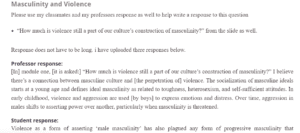Masculinity
How much is violence still a part of our culture’s construction of masculinity?
The culture of masculinity has long been applauded as a nationalist enterprise where males use violence to strengthen a country’s power. For instance, in the past, powerful nations sought to dominate foreign peoples and countries, colonizing them. More so, people celebrate military violence demonstrating the embedded masculinity culture. With this understanding, the adoption of behavioral patterns of masculine epitomes’ surrounding culture begins at a tender age. It describes the ideal masculinity as hardiness, hetero-sexuality, and self-reliance perspectives. Thereby, compulsive masculinity violence seems to plague any aspect of progressive masculinity that marginalized men experience. For example, men within the LGBT society face violent attacks from the established notion of masculinity. The global community regards aspects embodying a man, including lacking emotional intelligence and demonstrating military toughness. I believe males use violent behaviors to show dominance and power, especially when threatened. To some extent, the conservative view of compulsive masculinity is harmful to the new wave of progressive masculinity that embraces emotional intelligence. Basing masculinity on admirable personality characteristics is challenging when society is overshadowed by male virility that embraces physical attributes regardless of negative traits.
ORDER A PLAGIARISM-FREE PAPER HERE
We’ll write everything from scratch
Question
Masculinity and Violence
Masculinity
Please use my classmates and my professors response as well to help write a response to this question

Masculinity
- “How much is violence still a part of our culture’s construction of masculinity?” from the slide as well.
Response does not have to be long. i have uploaded there responses below.
Professor response:
[In] module one, [it is asked:] “How much is violence still a part of our culture’s construction of masculinity?” I believe there’s a connection between masculine culture and [the perpetration of] violence. The socialization of masculine ideals starts at a young age and defines ideal masculinity as related to toughness, heterosexism, and self-sufficient attitudes. In early childhood, violence and aggression are used [by boys] to express emotions and distress. Over time, aggression in males shifts to asserting power over another, particularly when masculinity is threatened.
Student response:
Violence as a form of asserting ‘male masculinity’ has also plagued any form of progressive masculinity that marginalized male groups (such as males within the LGBT community & feminine men) often exhibit. Prior definitions of what is a man and what makes a man masculine, is now referred to as ‘Hyper-masculinity.’ This idea of hyper-masculinity is defined [as mentioned] by ‘toughness’, heterosexism, and the lack of emotional intelligence. I think that the new distinction helps to point out the idea that this dated form of masculinity is sort of an overcompensation and more harmful than not. The new recent wave of progressive masculinity has made it easier for men to embrace emotional intelligence and base their masculinity on admirable personality traits as opposed to physical attributes and negative personality traits.
Please use my classmates and my professor’s response as well to help write a response to this question “How much is violence still a part of our culture’s construction of masculinity?” from the slide as well. Response does not have to be long.

